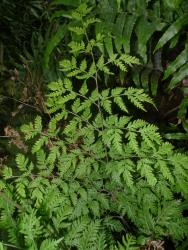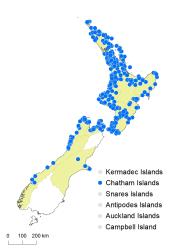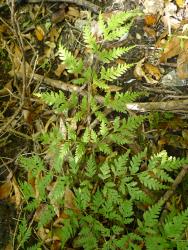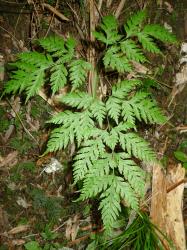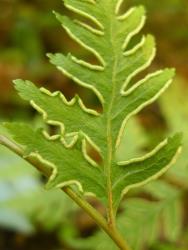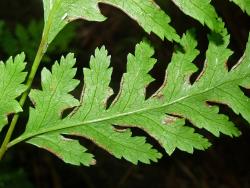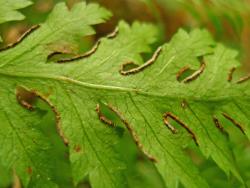- ≡ Litobrochia macilenta (A.Rich.) J.Sm., J. Bot. (Hooker) 4: 163 (1841)
- = Pteris pendula Colenso, Trans. & Proc. New Zealand Inst. 20: 218 (1888)
- ≡ Pteris macilenta var. pendula (Colenso) Cheeseman, Man. New Zealand Fl. 973 (1906)
Rhizomes erect, scaly. Rhizome scales narrowly ovate, 3.5–7.5 mm long, 0.4–1.5 mm wide, pale brown or red-brown, concolorous, entire. Fronds 200–1550 mm long. Stipes 70–820 mm long, red-brown proximally, yellow-brown or chestnut-brown distally, with scattered pale brown or red-brown scales up to 9 mm long and 2 mm wide, especially proximally. Rachises yellow-brown or rarely chestnut-brown, narrowly winged only in distal half, bearing scattered scales. Laminae deeply 2‑pinnate‑pinnatifdid to 4-pinnate-pinnatifid, 130–900 mm long, 60–750 mm wide, ovate to broadly ovate, pale green, herbaceous or rarely coriaceous, bearing scattered scales on the costae. Primary pinnae in 3–9 pairs below pinnatifid apex, not or scarcely overlapping; the longest at or near base, 45–750 mm long, 25–350 mm wide, narrowly ovate to ovate, straight; pinna apices acute to acuminate, bases long-stalked. Longest secondary pinnae 16–290 mm long, 8–160 mm wide, ovate to elliptic, ± alternate; apices acute to acuminate, bases stalked; basal basiscopic secondary pinnae on basal primary pinnae not markedly longer than the others. Longest tertiary pinnae 9–85 mm long, 3–60 mm wide, ovate or narrowly ovate; apices acute, margins indented to deeply divided, bases sessile or short-stalked. Ultimate lamina segments up to 38 mm long, 19 mm wide. Veins anastomosing. Sori elongated along margins of the ultimate segments. Mean exospore diameter 41–46 μm.
Note: Measurements given above are from herbarium specimens. Larger fronds are known to occur in the wild. AK 141374, from the Waitākere Ranges, Auckland, comprises parts of a frond said to measure 1800 mm long.
Pteris macilenta is distinguished by its erect rhizome, deeply 2-pinnate-pinnatifid to 4‑pinnate‑pinnatifid laminae, anastomosing veins, non-overlapping pinnae, usually herbaceous lamina segments, and secondary pinnae that are mostly stalked on the lowermost primary pinnae. It is very similar to P. saxatilis, but is generally a larger plant with slightly more coriaceous laminae and less widely spaced pinnae. The secondary pinnae on the lower primary pinnae are more obviously alternate rather than sub-opposite. It also has larger spores than those in P. saxatilis (exospores 41–46 μm, cf. 32–37 μm in diameter). Plants of P. macilenta are believed to hybridise with both P. saxatilis and P. carsei, making identification difficult in areas where the species overlap. It differs from P. epaleata in having secondary pinnae that are more obviously stalked, ultimate segments that are shorter and broader, and scales on the rachises and costae that are ovate rather than hair-like.
North Island: Northland, Auckland, Volcanic Plateau, Gisborne, Taranaki, Southern North Island.
South Island: Western Nelson, Sounds-Nelson, Westland, Canterbury, Fiordland.
Chatham Islands.
Altitudinal range: 0–800 m.
Pteris macilenta occurs in coastal and lowland areas throughout the North Island from Te Paki to Wellington, extending locally into montane districts. It is rare in the central North Island. It grows from near sea level, reaching 800 m in the Coromandel Ranges and on Mt Pirongia. In the South Island, the species is common only in coastal and lowland regions from the Marlborough Sounds to Greymouth, reaching 520 m near Nelson. There are outlying populations in Canterbury and along the West Coast as far south as Martins Bay. The species also extends to the Chatham Islands.
Pteris macilenta is a terrestrial fern found under coastal forest, drier and more open kauri, podocarp, beech, and broadleaved forest, and mānuka and kānuka scrub. It is also found under Carex secta. It grows on scoria, greywacke and limestone rock, favouring streambanks, river terraces, wet gullies, clay banks, clearings, forest margins, roadside banks, coastal cliffs, and the bases of rocky bluffs.
Pteris macilenta is believed to hybridise with P. saxatilis in areas where they overlap (e.g. AK 353155, 353276, 353488, CHR 210968, 292779). Spores of putative hybrids are often abnormal in appearance because of the difference in chromosome number between the two species, but are not as easy to detect as in genera such as Asplenium or Polystichum. Whether P. macilenta also crosses with P. carsei is not known with certainty because it is difficult to distinguish this combination from the common hybrid between P. saxatilis and P. carsei. It is likely on morphological grounds that P. macilenta is an allotetraploid derivative of the two diploid species, although experimental evidence for this is lacking, and all three species have very similar chloroplast DNA sequences, indicating a close relationship (Bouma et al. 2010).
n = 60 (Brownlie 1961); n = 58, 2n = c. 116 (Walker 1962); 2n = c. 120 (de Lange et al. 2004 – as P. aff. macilenta).
Braggins (1975), in his unpublished thesis, interpreted Richard’s P. macilenta to be the correct name for the plant subsequently known as P. saxatilis, and proposed that P. pendula, described by Colenso (1888), be used for the plant that had been called P. macilenta. Although his thesis was never published, the names P. pendula and P. macilenta were adopted by some collectors, whereas others continued to use P. macilenta and P. saxatilis. As a consequence, the names have been used in different senses, and a significant amount of herbarium material was confusingly identified. Brownsey & Perrie (2020) selected the only element that is definitely original material of Richard's name as the lectotype (P 00610503), and since this is a specimen of what is currently called P. macilenta, the name is retained in its traditional sense.
Plants growing in limestone areas from the Heaphy Track south to Greymouth, especially around Punakaiki, have rather fleshy fronds, and primary pinnae that are more winged than in populations elsewhere. They also have a mean exospore size (36–41 μm diameter) intermediate between those of the tetraploid P. macilenta (41–46 μm diameter) and the diploid P. saxatilis (32–37 μm diameter) and P. carsei (33–36 μm diameter). These plants may be an environmental form, or they may represent allotetraploid plants that have had a separate origin from populations elsewhere. They are not given any taxonomic status here, but require further investigation.



